Best Type of Cosmos Flower Varieties & Species
There are three main types of cosmos. All types of cosmos flower varieties can be clubbed under one of these three types.
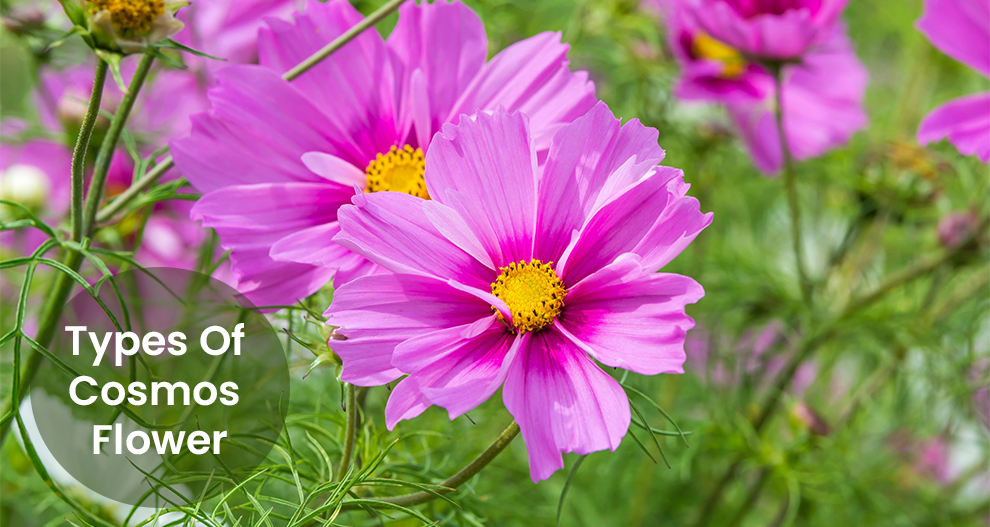
Cosmos are members of the sunflower family. They make excellent companion plants, attract butterflies, and bloom until the first frost, ensuring an attractive late-summer color. There are almost 30 different types of cosmos flowers which belong to three main species. You will find variation in the cultivators and the species, giving you myriad ways to enjoy the cosmos in your yard or garden.
Regardless, almost all varieties are inexpensive and easy to grow and yield several beautiful daisy-like flowers that you can cut for the vase during early autumn and summer.
Native to Mexico, the cosmos bloom in orange, white, and pink, and sun-based scrub and meadows. This guide will discuss all kinds of cosmos.
What Kind Of Flowers Are Cosmos?
Cosmos are October’s birth flower and belong to the Compositae genus.
These are herbaceous perennials. Typically, they grow to an average height between three to six feet. They have simple, pinnate, or bipinnate leaves, and their arrangement is in opposite pairs. You can find their flowers in several breathtaking colors like pink, solid pink, maroon, and white, with flares in deep pink.
These plants bloom once in a season or two times per year. Its flowers bloom well in the season but die when the first frost occurs. If the Cosmo flower seeds fall on the bare ground, they will re-grow in spring. Cosmos seeds are the most effortless to grow.
Is The Cosmos A Sunflower?
Cosmos are not sunflowers, but they both belong to the Sunflower family.
Types of Cosmos Flower
Cosmos belong to the Asteraceae genus in the Aster family, which comprises around thirty species. However, only three of them are widely available for use in beautifying gardens. These include:
A. Cosmos bipinnatus
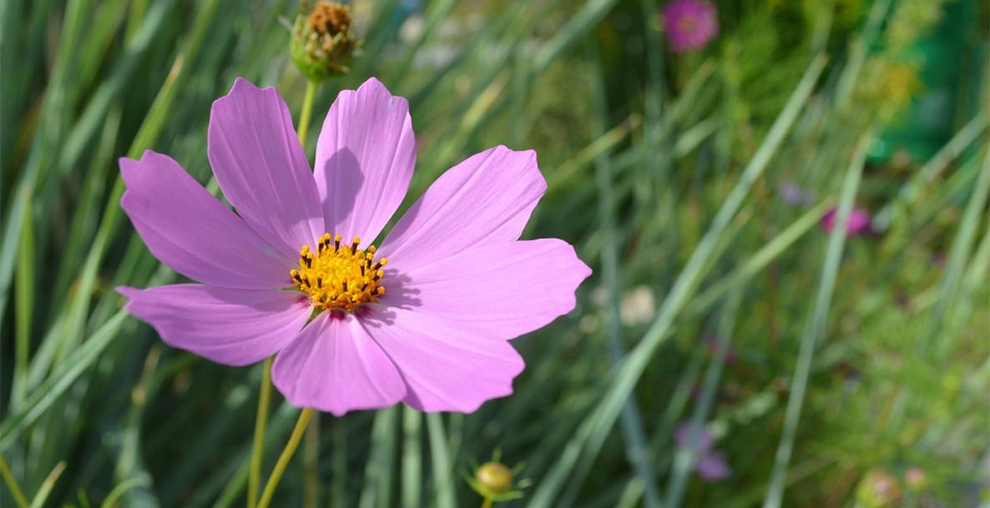
Cosmos bipinnatus has thread-like foliage. They are wispy, fine, delicate and one of the most commonly found cosmos flower species. You are probably most well-acquainted with it. These are prevalently known as the tall cosmos or the garden cosmos, and the plant holds its flowers aloft on its medium green, delicate stem.
There is a myriad of cultivators for Cosmos bipinnatus, and you will mostly find them in shades of pale yellow, purple, red, pink, and white. The bright yellow nucleus is in sharp contrast with the vibrant petals.
Its flower head has variable size and usually goes from three to six inches wide. Native to Mexico, Cosmos bipinnatus is also known as the Mexican Aster, but it has naturalized in parts of Canada and America, along with other parts of the world.
You can find different types of cosmos flowers & their cultivars in this category, ranging from lankier types that grow six feet or taller to dwarf varieties that cease at only two feet.
You will most likely shop for them as annual breeding plants from the garden centers, but they are sown directly into the garden or started as annuals or indoors and transplanted outdoors post the last spring frost. They thrive in USDA hardiness zones two through eleven.
It takes at least seventy days to show the first blooms if planted from the seeds. However, the actual time varies from cultivar to cultivar. These species do best in full sun but are tolerant to part shade, but ensure they get at least six hours of direct sun every day.
They need moderate watering but can withstand the dry conditions after it establishes. You can get more blooms from the soil that is not very rich.
Different types of flowers under this category of cosmos are:
1. Purity
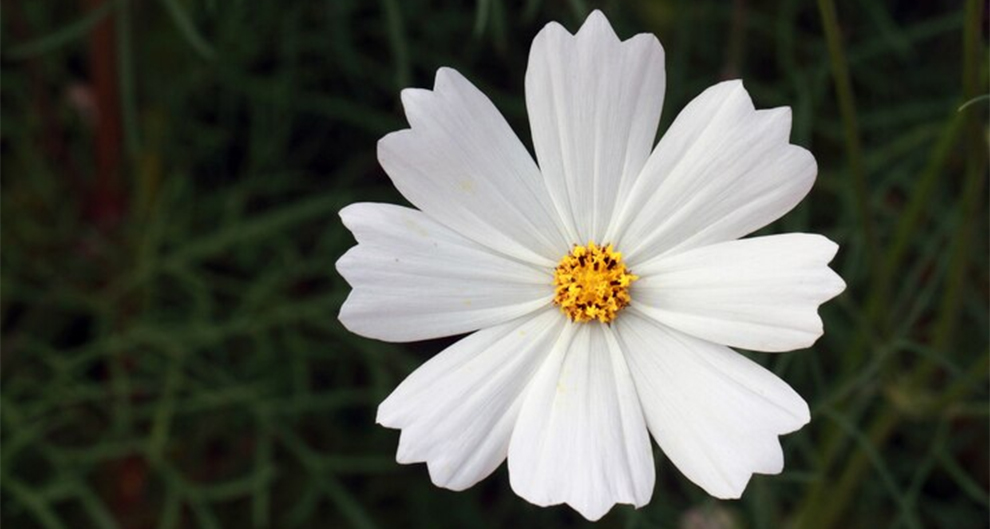
| Scientific name | Cosmos Bipinnatus ‘Purity’ |
| Bloom time | June to October (Early summer until the frosts return in fall) |
| Color | White |
| Height | 4 feet |
If you wish to grow a cosmos in your garden borders and beds, Purity has to be a safe pick. It has vast crisp-white daisy flowers with golden centers that bloom over its apple-green foliage, creating a wonderful sight to look at.
The plant best grows in USDA hardiness two through eleven and are half-hardy annuals. It is a beautifully cut flower that grows in well-drained, lightly fertile, and moist soil under full sun. Their flowers are pure white and large. They can easily last in the vase for ten days, which makes them a fantastic ornamental variety.
2. Sonata
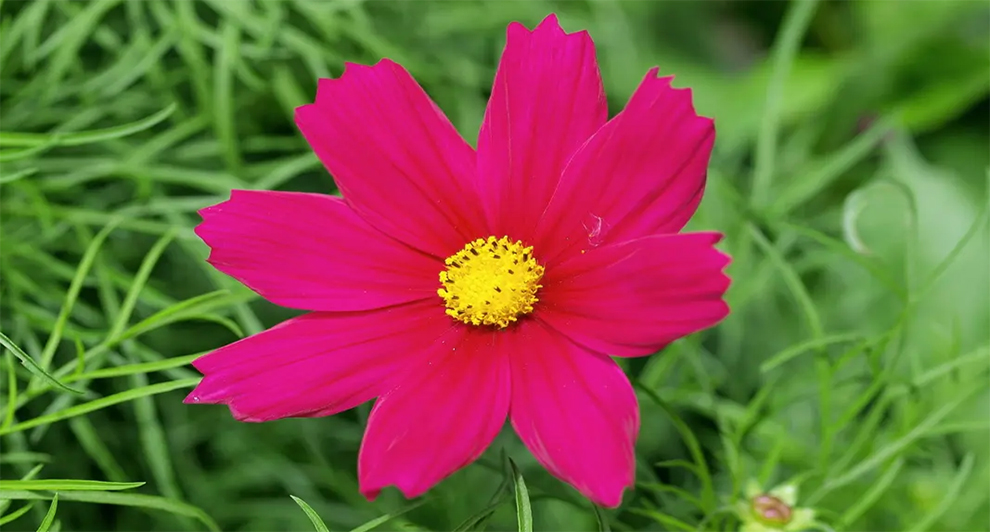
| Scientific name | Cosmos bipinnatus ‘Sonata’ |
| Bloom time | Early to late summer |
| Color | Carmine, pink, and white with a golden base |
| Height | 20 to 24 inches |
These flowers bloom early and are compact plants perfect for garden borders and containers. Their flower colors include carmine, pink, and white with a golden base. Sonata is low-maintenance, pest-free plants that make for excellent cut flowers.
So, you can easily enjoy their beauty indoors in garden vases. Sonata thrives in lightly fertile, well-drained soil with full sun. They make fantastic cutting gardens, garden borders, wild gardens, beds, and cottage gardens.
3. Cupcakes and Saucers
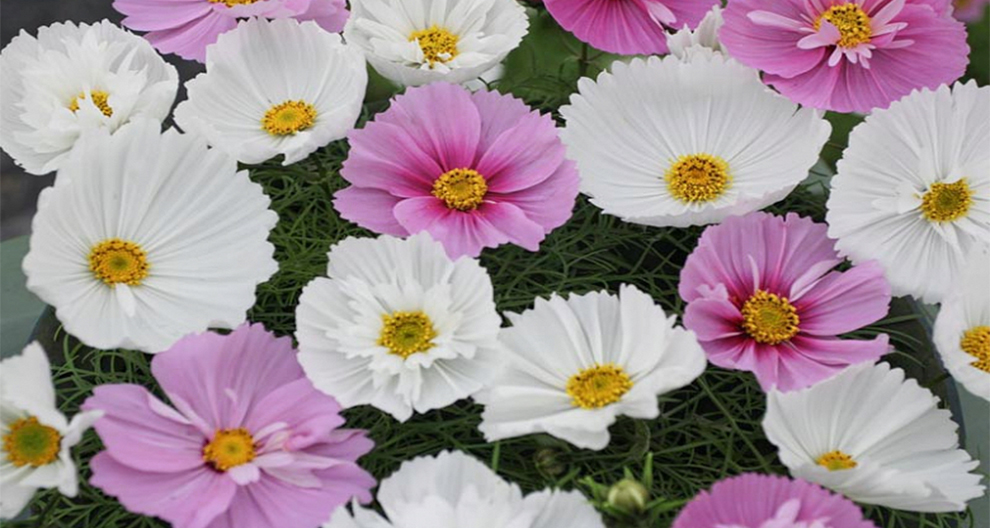
| Scientific name | Cosmos bipinnatus ‘Cupcakes and Saucers’ |
| Bloom time | Mid-summer to mid-fall |
| Color | White, pink, and lavender, with yellow centers |
| Height | 4 feet |
It is a variation of the Cupcake White cultivator and is an attractive specimen. Its outer petals are fused into a chalice shape and are an out-of-ordinary variety. Its flowers have frilly petals within the chalice.
These cosmos flower varieties have four-foot plants with semi-double and double flowers. With two feet spread, these can be an excellent pick to fill your flower beds with attractive and colorful blooms. It is easy to grow from seeds, and germination takes seven to fifteen days.
4. Sea Shells
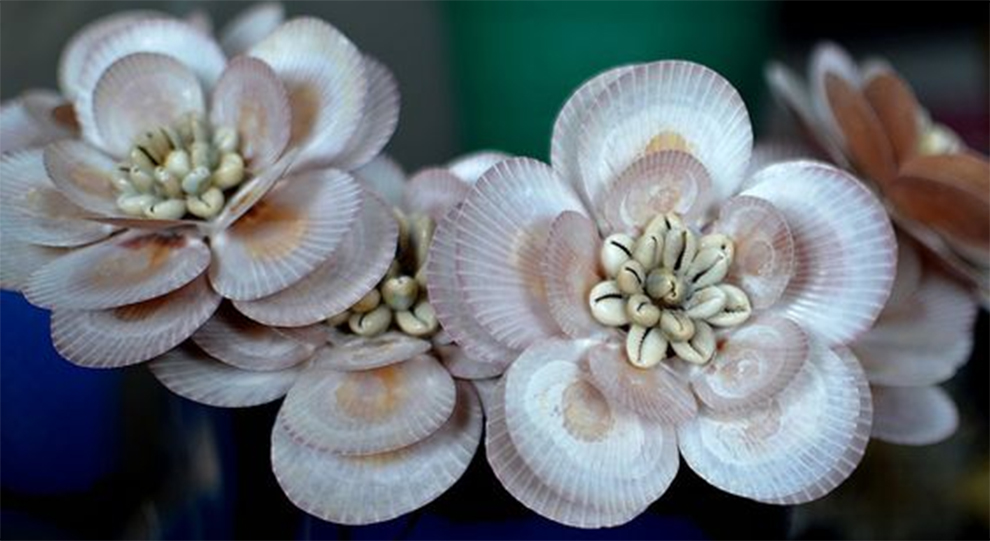
| Scientific name | Cosmos ‘Sea Shells’ |
| Bloom time | From summer to fall |
| Color | White, pink, rose, and crimson |
| Height | Three to five feet tall |
It is a beautiful and sophisticated cosmos flower species from the Cosmos bipinnatum variety, known primarily for its fluted pink tubular petals enveloping the yellow central florets. You can also find them in several colors, like white and red.
The plants grow around three feet tall and about two feet wide. Sea shells grow best as annuals in USDA hardiness zones two through eleven. They are phenomenal cultivators, which are ideal for pollinators like butterflies.
Sea shells usually take a little longer to attain maturity than the other selections. Hence, you must be prepared to give them at least 90-110 days from the sowing for the initial buds to show.
5. Double Click Cranberries
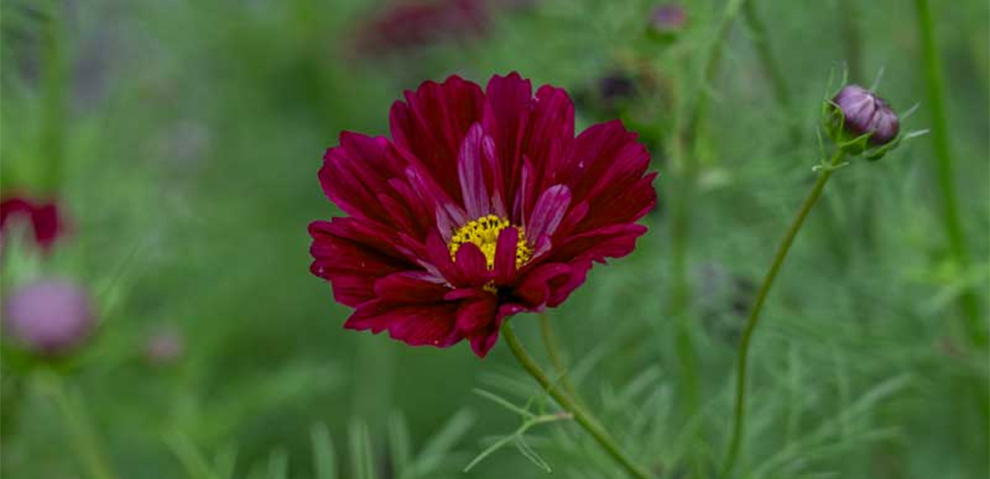
| Scientific name | Cosmos bipinnatus Double Click Cranberries |
| Bloom time | Early summer to fall |
| Color | Rich burgundy |
| Height | 3 to 4 feet |
It is one of the best cosmos varieties, but sadly you may not have the ideal conditions for growing cranberries in your yard. However, if you live in USDA zones two through eleven, you can plant flowers of a similar rich hue.
This variety comes in rich burgundy and yields semi-double or double blooms. The flowers are around two to three inches wide and held aloft on sturdy stems, making them perfect for flower arrangements. Its flowers bloom 60-90 days after sowing.
B. Cosmos sulphureus
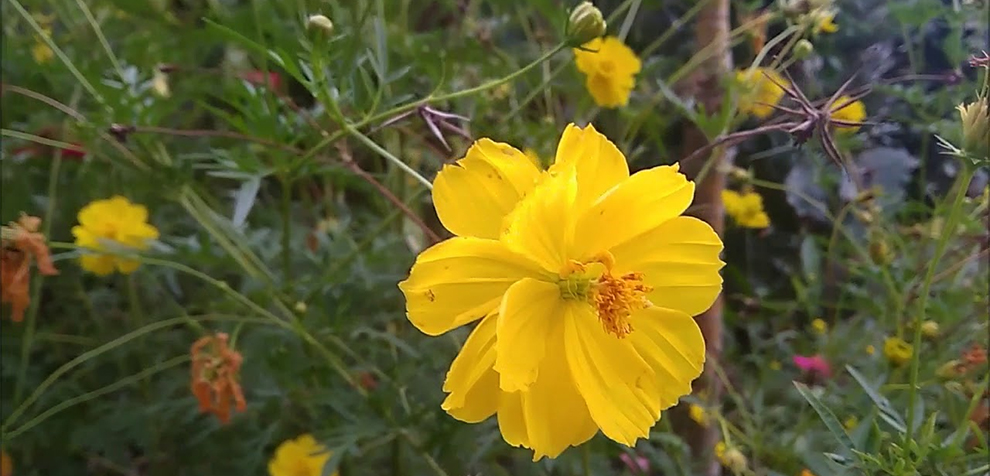
People usually confuse this cosmos variety with marigolds at first glance. Like marigolds, even these have a color palette comprising fiery red, orange, and bright yellow with matching centers. Their heads are mostly one to two inches wide.
Similar to Cosmos bipinnatus, even Cosmos sulphureus is native to Mexico but has naturalized in parts of America. It is more prevalently known as sulfur cosmos, but many even refer to it as yellow, orange, or klondike cosmos.
These cosmos flower varieties can be a little shorter than the Cosmos bipinnatus, wherein most cultivars usually grow to be one to three feet tall, but some species even reach six feet. They are not as wispy and fine as the garden cosmos and look more like marigold foliage. They hold their warm-hued blooms on hairy stems.
They are predominantly found as annual bedding plants at garden centers and are easy to start from seed. You can commence them indoors as annuals or sow them directly into the garden. They grow best in USDA zones two through eleven.
Cosmos sulphureus have similar growing conditions to Cosmos bipinnatus. These cosmos flowers demand at least six hours of sun, free-draining soil, and moderate watering, but they are also drought-tolerant.
1. Bright Lights
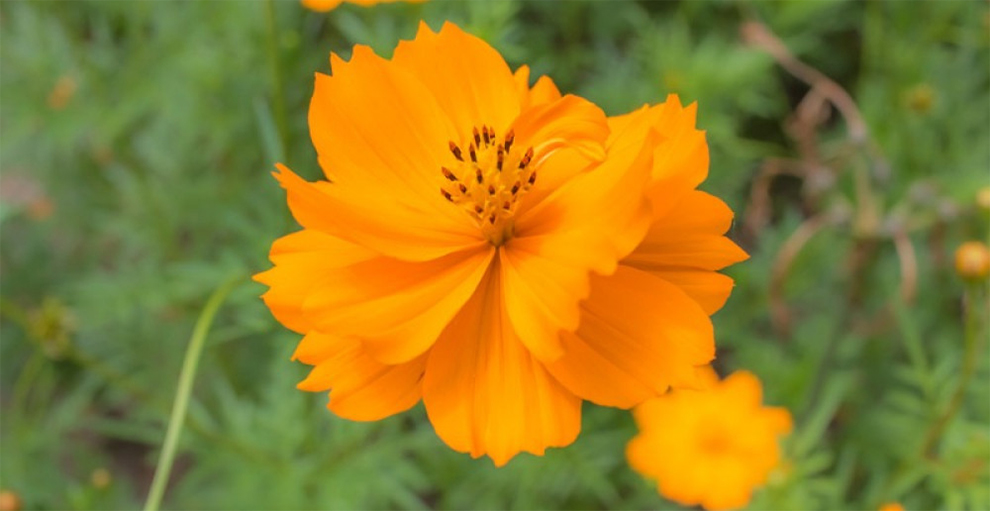
| Scientific name | Cosmos sulphureus Bright Lights |
| Bloom time | Summer till fall (June to October) |
| Color | Scarlet, orange, gold, and yellow |
| Height | 3 feet |
These are a mix of Cosmos Sulphureus blooms, which come in various shades, from scarlet to orange, gold, and yellow. These semi-double blossoms resemble marigolds or geums, which measure around two and a half inches across and beautifully cover the plant that grows three feet tall.
They thrive in USDA hardiness zones two through eleven. These types of cosmos flowers are floriferous and easy to grow. They thrive in full sun with well-drained and moist soil. Bright lights make for excellent-cut flowers.
So, you can enjoy them indoors in the vase. Bright Lights look even more attractive when paired with a colorful palette in the garden comprising velvet, raspberry pink, and lime shades. Since they have flowers that grow brightly, they get their name the Bright Light.
2. Diablo
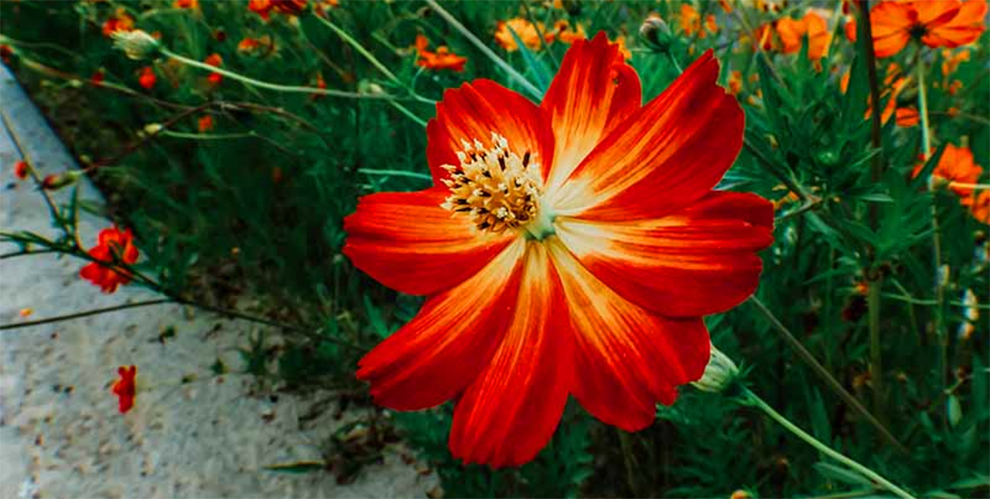
| Scientific name | Cosmos ‘Diablo’ |
| Bloom time | Early summer through late fall |
| Color | Reddish, fiery orange |
| Height | 4-5 feet with a 2-3 feet spread |
If you love the hot summer days, you might wish to add warm color to the landscape. For that, Diablo can be a good pick. It is heirloom cosmos flower species of sulfur cosmos and has a reddish, fiery orange color that can bring the heat.
They are taller than Bright lights, grow up to four to five feet tall, and accommodate their two-inch flowers on the wiry stems. Diablo has a pedigree and was christened an All-America Selections winner in 1974.
These have sturdy wiry stems and rich green foliage and germinate within ten days. Originating in Mexico, this variety thrives as an annual in USDA zones three through eight. They attract pollinators like butterflies and bees.
3. Cosmic Yellow
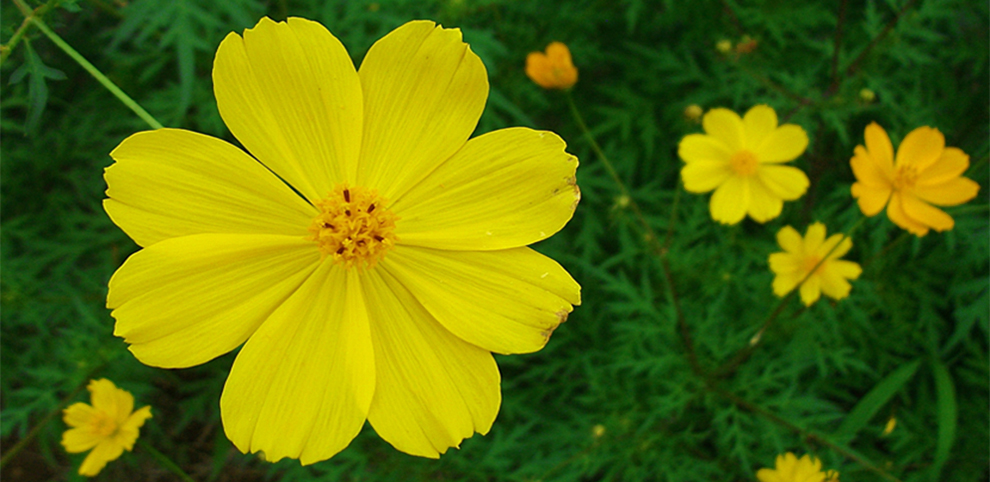
| Scientific name | Cosmos Sulphureus ‘Cosmic Yellow’ |
| Bloom time | June to September |
| Color | Yellow-golden |
| Height | 6 feet |
Cosmic Yellow is an ideal pot plant that thrives in USDA hardiness zones two through 11. These cosmos flower varieties have sun-yellow flowers, which look like coreopsis, the tiny cultivator that can brighten up your patio garden. Every flower is around 2 ½ inches.
The plant thrives in well-drained pots in the sun, but please keep the compost moist for the best results. They are easy to grow and maintain and work as excellent cut flowers. They are not only good garden plants but also phenomenal ornamental varieties.
As one of the most vibrant and brightest cosmos, they are stunning additions to any space. Currently, the Yellow Cosmos are endemic to Mexico and other parts of South and Central America. They are ideal as an annual in the gardens.
C. Chocolate cosmos (Cosmos atrosanguineus)
Also called the chocolate cosmos, the C. atrosanguineus is native to northeast Mexico. Its flowers range from deep red to chocolate maroon with similar centers and held onto wiry stems. These cosmos flowers are christened not only for their coloring but for their smell.
These velvety, richly-hued blooms have a chocolaty fragrance, which is easily discernible, especially on warm days.
They are compact plants that grow 30 inches high with an 18-inch spread. The plant has dark-green foliage and is prevalently available for purchase as a tuber or live plant. You can also grow them from seeds. These need full sun to grow but thrive in well-draining soil that is not overly fertile.
These are one of the best cosmos varieties because they are drought-tolerant. You must never try to overwater or overfeed them. In USDA hardiness zones nine through eleven, they can be treated as perennials. However, they can also be perennials in Zones seven through eight, provided you offer heavy mulching.
1. Choca Mocha
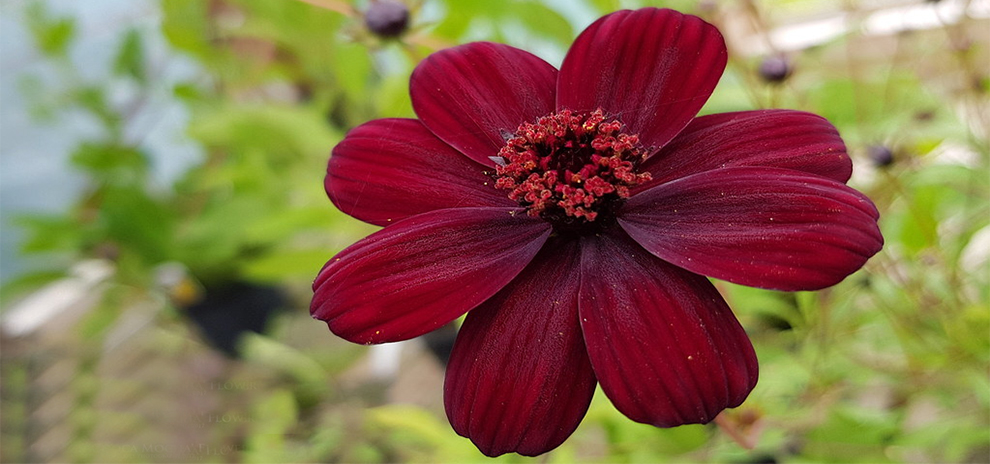
| Scientific name | Cosmos Atrosanguineus Choca mocha |
| Bloom time | Mid-summer to fall |
| Color | Deep brown-red petals with dark centers |
| Height | 1 feet |
If you love dark chocolate, you will probably love your cosmos dark too. Choca Mocha is a wonderful cultivar of the C. atrosanguineus, a specie fondly called the chocolate cosmos, famous for its smell and color.
They have dark centers and deep brownish-red petals, which measure 1 ½ inches across and have an aromatic chocolatey fragrance. The single blooms develop on petite plants, around 10-12 inches tall. Like other cosmos flower varieties of C. atrosanguineus, even Choca Mocha is propagated via tubers or live plants instead of seeds.
It is a chocolatey delight. These thrive in USDA hardiness zones seven through nine and are ideal for overwintering indoors. You can enjoy the bonsai version of the species in a well-drained container. For best growth, please water them regularly.
Related: Perennials That Bloom All Summer | Winter Flowering Trees | White Flowering Trees| Types of Hibiscus Flowers
Some More Information About Cosmos Flower
Ques 1. Which is the best cosmos for cut flowers?
Ans. Sea shells and cupcakes and saucers are ideal for cut flowers. They look pretty amazing in a vase.
Ques 2. Which variety of cosmos is the tallest?
Ans. Cosmos bipinnatus ‘Versailles Dark Rose’ is the tallest with a 2.5 meters height.
Ques 3. Which are the perennial cosmos?
Ans. Cosmos atrosanguineus is the perennial cosmos among their different types of cosmos flowers.
